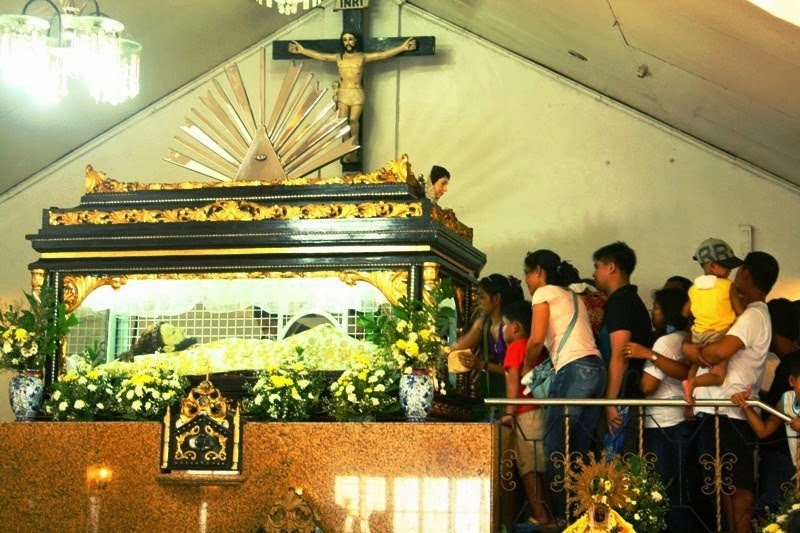Calabanga is a first class municipality in the province of Camarines Sur, Philippines. It is composed of 48 barangays, 14 of which are within the urban area and the remaining 34 barangays are within the rural areas. According to the 2010 census, it has a population of 78,119 people,and a land area of 16,380 hectares (40,500 acres), which constitutes 3.1% of the province’s land area.
It is bounded on the west by the Bicol River and beyond the municipality of Cabusao; on the south by the municipality of Bombon and Naga City; on the east by the forest lands of Mount Isarog, the Tigman River and each tributary forming the natural boundary and beyond the municipality of Tinambac; on the north by the fishing grounds of San Miguel Bay, and beyond, the municipalities of Sipocot, Basud and Mercedes.
It is bounded on the west by the Bicol River and beyond the municipality of Cabusao; on the south by the municipality of Bombon and Naga City; on the east by the forest lands of Mount Isarog, the Tigman River and each tributary forming the natural boundary and beyond the municipality of Tinambac; on the north by the fishing grounds of San Miguel Bay, and beyond, the municipalities of Sipocot, Basud and Mercedes.
Barangays
Calabanga is politically subdivided into 48 barangays, fourteen (14) of which are within the urban area while the remaining 34 barangays belong to the rural areas. It has 11 coastal barangays.
- Balatasan
- Balombon
- Balongay
- Belen
- Bigaas
- Binanuaanan Grande
- Binanuaanan Pequeño
- Binaliw
- Bonot-Santa Rosa
- Burabod
- Cabanbanan
- Cagsao
- Camuning
- Comaguingking
- Del Carmen
- Dominorog
- Fabrica
- Harubay
- La Purisima (Quipayo)
- Lugsad
- Manguiring
- Pagatpat
- Paolbo
- Pinada
- Punta Tarawal
- Quinale
- Sabang
- Salvacion-Baybay
- San Antonio Poblacion
- San Antonio (Quipayo)
- San Bernardino
- San Francisco
- San Isidro
- San Lucas
- San Miguel
- San Pablo
- San Roque
- San Vicente (
- Santa Cruz Pob.
- Santa Cruz (Quipayo)
- Santa Isabel
- Santa Salud
- Santo Domingo
- Santo Niño (Quipayo)
- Siba-o
- Sibobo
- Sogod
- Tomagodtod
History
In 1578 when the head Mission of Quipayo was established, Calabanga was only a visita or barrio. At that time, the place had vast forests and swamps and an abundance of wildlife such as monkeys, wild chickens, and forest lizard. Others say, it derived its name from the Bicol word “Calabangan”, the plural term of “labang” or “litag”, meaning a kind of snare for catching wild animals. Another legend says that Calabanga originated from the word “Calagbangan” meaning the wide, long, and straight street spanning from the church through the poblacion, east to west, called locally as “calabaan” or “calacbangan”.
Calabanga became known with 400 tributes. On July 15, 1749, it was separated from Quipayo by virtue of the approval of Don Fray Joan de Arechera, Bishop Elect of Nueva Segovia of the Commissary of the King, in the petition signed & filed by 37 Calabangueños on April 28, 1749 for town to be conveniently administered.
There were 2 visitas, visita de Cagapad and visita de hinarijan and 12 barrios. The barrios were san Antonio, San Vicente, Sta. Catalina, Nuestra Señora de Salud, San Lucas, San Miguel, Sta. Isabel, Nuestra Señora del Carmen, San Roque, San Pablo, San Jose (now Balongay) and Belen.
Calabanga is one of the municipalities of the province of Camarines Sur and a member of the Metro Naga Development Council. With its fishing grounds and the vast agricultural area, it is a major supplier of fish and other marine products and prime agricultural products in the province as well as in Metro Manila.
TripAdvisor
Amang Hinulid
Amang Hinulid, as popularly called by his devotees and
beneficiaries, is an image of the Lord Jesus in repose in his tomb. Thousands
of pilgrims coming from far flung localities would flock in Barangay Sta. Salud
in Calabanga town only to plant kiss to the image. To fulfill a promised
"pagsongko", one must devote himself into walking a twelve-kilometer
road stretch, if he comes from Naga, in the late night of Maundy Thursday or in
the early hours of Good Friday.
There are many accounts foretold by the family who owned the
statute about supernatural events that took place indicating that indeed Amang
Hinulid is a miraculous image. One narrative tells of a man with hemorrhoids
who had been healed upon dabbing the affected area with a cotton ball soaked in
coconut oil from the chapel's vigil lamp. There are other similar stories
recounted which revealed what the image of Amang Hinulid can do about a
person's health in both body and spirit.
The Village @ San
Bernardino
An
eco-friendly fully functioning agri-tourism resort located at San Bernardino,
Calabanga, Camarines Sur. It was founded on November 4, 2010 set for an
advocacy and promotion of agri-tourism projects, hence, increasing the
sustainability of livelihood programs for different communities. The resort
focuses mainly on its agri-aqua projects such as organic-vegetable farm;
culinary herbs garden; hatchery & grow-out for fishes, crabs & shrimps;
free-range chickens, ducks & geeses, dove houses and wild birds reserves.
Family owned and operated, it promotes sustainable, organic agriculture and
healthy living, while delighting Bicolano traditions of geniality and warmth.






